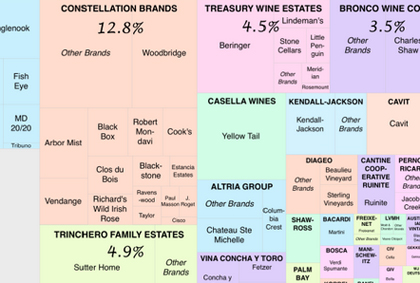Just how concentrated is the wine industry? [graphics]
Philip Howard, a professor at Michigan State specializing in food systems, has led a team to assemble a superb infographic that depicts just how big is Big Wine–and how few companies control choices at supermarkets.
He’s put the graphics on his web site. Now you can find out just which brands Gallo and Constellation own! (Not to pick nits, but it’s not clear why Pam Bay and W.J. Deutsch get separate boxes than two of the brands they import, Cavit and Yellow Tail, respectively.)
The US wine industry has been quite concentrated in much of the post-Prohibition era, especially compared to France or Italy, which are dotted with small vignerons. This corporate concentration is most on display at the drug stores (!) and grocery stores that the Michigan team visited (those store buyers buy from distributors–a graphic of wine distributor consolidation would be really fascinating and probably more enlightening about wine consumer choices.) Fortunately, even if Big Wine is pretty big, there is a tasty countermovement underway in California (and elsewhere) as new, small labels are popping up–one of my exciting trends to watch for 2013. The hardest part is finding the wines, which is where specialty wine shops are invaluable.
Click through and zoom to learn which wine brands Altria, the cigarette maker, owns. Also check out Howard’s graphics on beer and coffee industries!





On January 3rd, 2013 at 3:19 pm ,Jon Bjork wrote:
I’d love to see the top 10 distributors depicted with “tenticles” reaching out to all those brands from the other chart!
On January 3rd, 2013 at 3:41 pm ,Dr. Vino wrote:
Jon, I agree! As I mentioned in the posting, the consolidation of distributors is probably the most important aspect of consumer choice. Sadly, it is also the least known. So focusing Howard’s excellent graphical skills on it would be a real service to wine consumers!
On January 4th, 2013 at 9:55 am ,Jacques Herviou wrote:
I think this is great information (although, I was also surprised that Cavit/Palm Bay and Yellow Tail/Deutsh/Duboeuf were listed separately). As for distributors, I don’t think they are thrilled with this concentration as they are increasingly micro-managed by Big wine.
On January 4th, 2013 at 10:24 am ,RobinC wrote:
We’re getting Total Wine in our city. I’d be interested in knowing their sources. I couldn’t find it on the web.
On January 4th, 2013 at 1:13 pm ,Bill Haydon wrote:
That’s a very good point, Jacques. As an importer, I’ve always had a rule of thumb that I never want a single supplier or customer to amount to more than 10% of my total revenue. It gives them too much control over your business.
On January 4th, 2013 at 3:21 pm ,Daniel wrote:
And yet, Bill, Southern Wines and Spirits is responsible for over 20% of all wines and spirits sales in the entire United States.
On January 4th, 2013 at 4:18 pm ,Dr. Vino wrote:
Robin – Total Wine likely sources wine from various distributors in your state. Distributors, in turn, source from importers and wineries. If you’re curious about the store inventory, I’m sure you could strike up a conversation with the store manager.
Jacques and Bill – perhaps, through things such as tied sales (where legal!). But distributors also probably aren’t wild about retailer consolidation. The Total Wines of Robin’s neighborhood can have greater buying heft. Sam’s Club and Costco account for a vast share of wine retail in the US.
Daniel – yes, that’s a big number!
On January 4th, 2013 at 4:22 pm ,Dr. Vino wrote:
One other point this chart drills home: wine writers and wine geeks tend to inhabit the bottom right part of the chart, so there’s an ocean of wine out there that is sold through ways other than critical write-ups, scores, sommeliers or hand-sells. It’s really a dual wine market in a lot of ways.
On January 7th, 2013 at 11:56 pm ,Roy Tennant wrote:
The long tail is long indeed! We have many very small wineries in the Sonoma Valley that produce wines that consistently outperform the large conglomerates on the price/quality spectrum. Check us out!